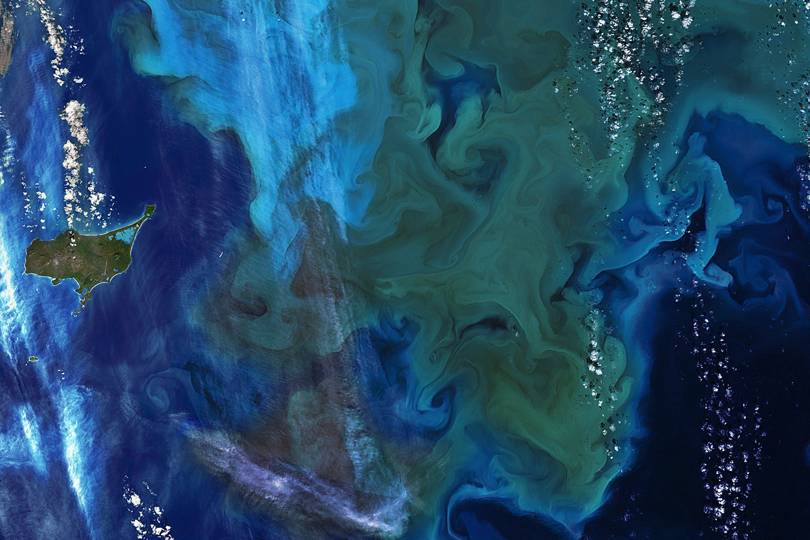Drones can be used to track algal blooms which could threaten the lives of hundreds of ocean species
credit : NASA
From Wired by Emma Bryce
Autonomous gliders, cameras and sensors trawl the oceans looking for signs of environmental changes
In 2015, a weak monsoon season left parts of India with 40 per cent below average rainfall, its farmlands littered with withered crops.
To prepare farmers against future unpredictability, experts are now turning to a team of robots, adrift in the sea.
Researchers from the University of East Anglia and the Indian Institute of Science have joined up to deploy seven robots, called gliders, along India's coastline, for the £8 million Bay of Bengal Boundary Layer Experiment (BoBBLE).
Every three hours these winged machines autonomously sink to 1,000 metres and rise again, using sensors to detect mixing between currents in the ocean that bring heat to the surface and drive monsoons.
"They generate forward movement using their wings; they can direct their path to wherever you tell them to," says Ben Webber, a University of East Anglia oceanographer working on BoBBLE, and piloting the gliders from the UK.
In 2017, BoBBLE researchers will begin analysing the results: combined with atmospheric data, the robots' readings will provide closer predictions on the extent of monsoon rainfall and when it will hit land.
Fed back to farmers via weather stations and phone alerts, it could suggest best times for planting crops.
The BoBBLE gliders aren't alone: they join a 400-strong army of bots in the sea that are gathering varied data from around the world.
"The range of autonomous platforms that are becoming available is seen as the future of oceanography," Webber says.
Where we used to rely on costly ship missions to gather data from the ocean, we're turning to gliders, autonomous underwater vehicles and sensors - embedded on the sea floor, sunk into the water column or set adrift on the waves - to feed information back to us.
By exploiting the ocean as a vast information source, these instruments are providing unprecedented detail on everything from climate change to underwater volcanism and fisheries.
In 2017, as the technology makes its mark on the waves, we can expect to see an uptick in the data, bringing us new depths of understanding about the planet.
Operations engineer Chris Wahl deploys MBARI’s Wave Glider, Tiny from the
R/V Paragon for another mission.
Tiny is an autonomous surface vehicle
(ASV) that has a surfboard-like float with a tethered glider below,
equipped with spring-loaded paddles that use wave energy for motion.
Solar panels on its surface power the scientific instruments and
satellite communications as it travels.
We are beginning to use ASVs
instead of ships for certain well-defined, repetitive oceanographic
tasks.
We are also developing ways to use them as communication gateways
and navigation aids for autonomous underwater vehicles (AUVs).
Elsewhere, other instruments are measuring short-term changes - such as sudden blooms of toxic algae that threaten human and ecological health.
Off the coast of Washington State, pods called Environmental Sample Processors, developed by California's Monterey Bay Aquarium Research Institute, are sensing toxic blooms produced by Pseudo-nitzschia algae that threaten to infest edible shellfish onshore. "
[The Research Institute] had the vision of miniaturising a lab and leaving it out in the ocean," says Stephanie Moore, a scientist with the US National Oceanographic and Atmospheric Administration's Northwest Fisheries Science Center, who's working with University of Washington researchers to carry out the project.
Using a robotic arm, the pod takes a water sample, then withdraws it into the main body where it's screened for algal toxins using filters and reagents.
Within four hours, the pod's results can be transmitted via satellite as a warning if there's a threat.
With the incidence of harmful algal blooms rising globally - marked by coastal closures and mass strandings of animals that succumb to its toxins - the relevance of these algae-detecting units will grow.
In terms of scale, the most impressive data gathering is coming out of the Ocean Observatories Initiative (OOI), a huge venture launched in 2016 after ten years of construction on the sea floor.
It's made up of seven data-transmitting arrays that flank North and South America.
Each is surrounded by moorings that act as centre-points for over 830 instruments situated throughout the water column and on the sea floor.
These instruments - gliders, autonomous vehicles, cameras and seismic sensors - will feed a stream of information back to the arrays.
"To have it in one cohesive package with such a geographic range is absolutely unprecedented," says Richard Murray, director for the Division of Ocean Science at the US National Science Foundation, the organisation funding the $386 million (£293m) venture.
OOI's research remit is broad.
Its instruments will track changes in sea-floor geology that could trigger earthquakes; detect minute shifts in temperature, salinity and ocean mixing to map long-term climate-change trends; and identify nutrient flows to pinpoint productive fisheries.
Already, it's having real-world impacts. OOI's autonomous underwater vehicles are sensing nutrient upwellings along the eastern US coastline, and predicting how they'll drive fisheries, says Glen Gawarkiewicz, an oceanographer at the Woods Hole Oceanographic Institute, Massachusetts.
"I have been using some of the data to communicate with commercial fishermen about recent changes in the region," he says.
The platform isn't just for researchers, however.
Throughout their existence the arrays will be streaming data via cable and satellite in near-real-time to whoever wants to tune in.
"Anybody can use it, any state, any country, anybody, anywhere," Murray says.
"That's the way science should be."
He sees OOI's potential as an undersea laboratory where future technologies may be tested, furthering innovation.
"The. science will enable people to answer questions we haven't even asked yet," he says.
With the spread of seafaring instruments in 2017 and beyond, our ocean-based intelligence is projected to rise.
Links :


No comments:
Post a Comment